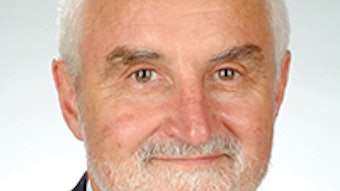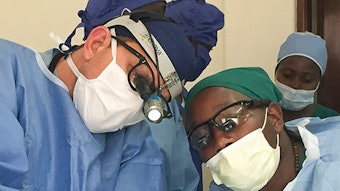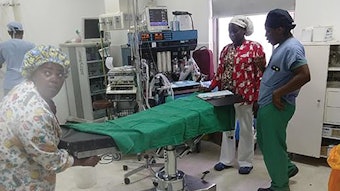Out of Committee: Outcomes Research and Evidence-Based Medicine
Tonsil surgery has been performed for millennia by techniques that have ranged from fingernail dissection in the first century AD to modern electrocautery today. Tonsillectomy refers to the complete removal of the encapsulated tonsil from the pharyngeal muscular wall. Tonsillectomy (with or without adenoidectomy) is the first-line treatment for sleep-disordered breathing (SDB) in children, and over 300,000 pediatric tonsillectomies are performed in the United States annually.
Tonsillectomy Versus Tonsillotomy for Pediatric Sleep-Disordered Breathing
Erin Kirkham, MD, MPH; Nikhila P. Raol, MD, MPH; Joshua R. Bedwell, MD; Derek J. Lam, MD MPH
Tonsil surgery has been performed for millennia by techniques that have ranged from fingernail dissection in the first century AD to modern electrocautery today. Tonsillectomy refers to the complete removal of the encapsulated tonsil from the pharyngeal muscular wall. Tonsillectomy (with or without adenoidectomy) is the first-line treatment for sleep-disordered breathing (SDB) in children, and over 300,000 pediatric tonsillectomies are performed in the United States annually.1 Tonsillectomy results in expected postoperative pain with decreased oral intake. The procedure also carries risks of more serious complications that can include dehydration, hemorrhage, severe airway compromise, and even death.

Tonsillotomy (also referred to as intracapsular or partial tonsillectomy) is a method of tonsillar debulking that spares the tonsillar capsule and avoids exposure of the pharyngeal musculature. As the most common indication for tonsil surgery in children has evolved from recurrent infection to SDB, the goal of surgery has changed from removal of a nidus for infection to the relief of upper airway obstruction. Proponents of tonsillotomy argue that while tonsillectomy may be necessary to prevent infection, tonsillotomy may suffice to reduce obstruction and may result in less pain and lower rates of bleeding. Critics of tonsillotomy cite unacceptable rates of regrowth, increased surgical time and cost, and doubt about clinically significant differences in pain and complications compared with tonsillectomy. Nonetheless, tonsillotomy has gained popularity in recent years with an associated increase in studies that compare intracapsular and total tonsillectomy with respect to a range of outcomes.
In this month’s Bulletin, we highlight a Cochrane review published by Blackshaw and colleagues that explores differences in outcomes between the techniques.2 The authors included 22 randomized controlled trials of tonsillectomy versus tonsillotomy (with or without adenoidectomy) for treatment of SDB in children aged two to 16 years. The authors did not exclude any studies based on the specific technique, such as electrocautery, cold steel, and coblation, used to perform either procedure.
Treatment of SDB
There were no significant short-term (zero to six months) or long-term (12-24 months) differences between the procedures with respect to improvement in disease-specific quality of life, SDB symptoms, behavior, or polysomnography measures.
Surgical time
Surgical time was 2.5 minutes shorter in favor of tonsillectomy.
Pain and recovery time
There was no evidence for a difference in pain scores at 24 hours, two to three days, or four to seven days postoperatively. Patients who underwent tonsillotomy were able to discontinue analgesics on average 2.8 days earlier, return to a normal diet on average three days earlier, and return to normal activity on average four days earlier than those who underwent tonsillectomy.
Short-term complications
Though there were no clinically meaningful differences in the volume of intraoperative blood loss, the authors found moderate evidence that, compared with tonsillotomy, tonsillectomy had 1.75 times the risk of subsequent medical intervention for dehydration, infection, or hemorrhage within seven days of initial surgery. However, the risk was low in both groups at 4.9% for tonsillectomy versus 2.6% for tonsillotomy.
Long-term complications
Children who underwent tonsillotomy did not have an increased risk of throat infection, recurrence of SDB due to tonsillar regrowth, or need for reoperation at six, 12, or 24 months of follow-up.
Limitations
Due to the heterogeneity of effect size estimates, wide confidence intervals, and high risk of various types of bias in the included studies, the conclusions drawn for the majority of the reported outcomes were of very low certainty. The exceptions to this were the need for medical intervention within the first week and return to normal function, where evidence was of moderate certainty. Variation in instrumentation and cost was not considered; however, a 2018 cost-effectiveness analysis found that monopolar tonsillectomy was more cost-effective than microdebrider tonsillotomy.3
Furthermore, the review included only randomized controlled trials with limited duration of follow-up, which is not the best study design to capture rare or long-term events. Longitudinal cohort studies conducted in Scandinavia suggest that tonsillotomy results in reoperation specifically on the tonsils in 3.9% of children but reoperation for either tonsils, adenoids, or both in up to 9.4% of children within three years.5 Overall, the risk of reoperation in the cohort was seven times higher for tonsillotomy than for tonsillectomy.4 This is strongly age dependent, with the highest rates of reoperation in children less than four years of age.5
Implications for practice
There is low-quality, limited evidence that tonsillotomy is no less effective for treatment of pediatric SDB than tonsillectomy, at least in the short term. There is moderate-quality evidence that tonsillotomy may confer short-term benefit in reducing immediate postoperative complications and facilitating faster return to normal activity. However, the short-term benefits of tonsillotomy must be balanced with respect to cost and the long-term probability of tonsillar regrowth, SDB recurrence, and the need for reoperation.
References
- Hall MJ, Schwartzman A, Zhang J, Liu X. Ambulatory surgery data from hospitals and ambulatory surgery centers: United States, 2010. Natl Health Stat Report. 2017;102:1-15.
- Blackshaw H, Springford LR, Zhang LY, Wang B, Venekamp RP, Schilder AG. Tonsillectomy versus tonsillotomy for obstructive sleep-disordered breathing in children. Cochrane Database Syst Rev. 2020;4:CD011365.
- Bagwell K, Wu X, Baum ED, Malhotra A. cost-effectiveness analysis of intracapsular tonsillectomy and total tonsillectomy for pediatric obstructive sleep apnea. Appl Health Econ Health Policy. 2018;16(4):527-535.
- Odhagen E, Sunnergren O, Hemlin C, Hessen Soderman AC, Ericsson E, Stalfors J. Risk of reoperation after tonsillotomy versus tonsillectomy: a population-based cohort study. Eur Arch Otorhinolaryngol. 2016;273(10):3263-3268.
- Sunnergren O, Odhagen E, Stalfors J. Incidence of second surgery following pediatric adenotonsillar surgery: a population-based cohort study. Eur Arch Otorhinolaryngol. 2017;274(7):2945-2951.













